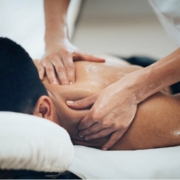Understanding the Differences: Manual Therapy, Lymphatic Drainage, and Deep Tissue Massage
Massage therapy has long been a go-to method for relieving tension, improving circulation, and promoting overall health. However, with so many different types of massage therapies available, it’s essential to know the key differences between them. Three commonly sought-after techniques are Manual Therapy, Lymphatic Drainage Massage, and Deep Tissue Massage. Each of these therapies serves a unique purpose and offers specific benefits depending on your needs. Here’s a breakdown of the main differences between the three.
1. Purpose and Focus
The first and most noticeable difference between Manual Therapy, Lymphatic Drainage, and Deep Tissue Massage is their primary focus and purpose.
Manual Therapy
Manual therapy is often referred to as a clinical or orthopedic approach to bodywork. It is primarily used to address musculoskeletal issues such as joint dysfunction, stiffness, or injury. Typically performed by physical therapists or chiropractors, manual therapy focuses on the manipulation of joints, muscles, and soft tissues to restore function and mobility. Techniques such as mobilization, stretching, and specific pressure applications are used to realign the body, reduce pain, and improve range of motion.
Lymphatic Drainage Massage
On the other hand, lymphatic drainage massage has a more subtle approach. The primary aim here is to stimulate the body’s lymphatic system, which is responsible for removing toxins, waste, and excess fluids from tissues. This gentle technique involves light, rhythmic strokes that follow the direction of the lymphatic flow. It’s especially beneficial for people dealing with lymphedema (swelling due to lymphatic system blockages), post-surgical recovery, or detoxification. The goal is to support the body’s immune system and enhance fluid circulation rather than focusing on muscular tension or joint mobility.
Deep Tissue Massage
Deep tissue massage targets deeper layers of muscles and fascia, making it a more intense experience. It’s specifically designed for individuals experiencing chronic muscle tension or injury. Unlike other forms of massage that emphasize relaxation, deep tissue massage applies sustained pressure using slow, deliberate strokes to break up adhesions (knots) and relieve chronic pain. The goal here is to address long-standing tension, realign deeper muscle tissues, and alleviate pain caused by conditions like sciatica, sports injuries, or fibromyalgia.
2. Techniques and Pressure
The techniques and amount of pressure applied during these massages significantly vary, which can affect the overall experience and result.
Manual Therapy
Manual therapy often involves various hands-on techniques that may include stretching, joint mobilization, and pressure application. The pressure can range from light to moderate depending on the goal of the therapy session. The movements are typically more precise, as they aim to improve joint function, reduce restrictions, and enhance mobility. Manual therapists may also use tools like ultrasound or electrical stimulation to complement the hands-on approach.
Lymphatic Drainage Massage
In contrast, lymphatic drainage uses the lightest touch among the three. This massage involves very gentle, rhythmic strokes, almost superficial, following the natural pathways of the lymphatic system. The technique is specific and requires trained practitioners who understand the lymphatic anatomy. Pressure is kept extremely light because the lymphatic vessels are located just under the skin, and applying too much force can obstruct the flow of lymph fluid.
Deep Tissue Massage
Deep tissue massage uses significantly more pressure compared to the other two. The therapist often uses their fingers, knuckles, elbows, and even forearms to apply sustained, deep pressure to reach muscles and fascia layers beneath the surface. Due to the intensity of the technique, it can be uncomfortable at times, but it is usually very effective in treating long-standing tension or chronic pain.
3. Results and Benefits
While all three therapies offer health benefits, the outcomes vary based on the type of massage and the individual’s needs.
Manual Therapy
The results of manual therapy are often functional. Patients typically seek this treatment to recover from injuries, improve mobility, and decrease pain in specific areas, such as the spine, shoulders, or hips. It’s common to undergo a series of sessions, as this therapy can be part of a larger rehabilitation plan for long-term relief and recovery.
Lymphatic Drainage Massage
The primary benefit of lymphatic drainage massage is enhanced fluid circulation and detoxification. Clients often experience reduced swelling, improved immune function, and a sense of overall well-being. This type of massage is particularly helpful for those recovering from surgery, cancer treatments, or dealing with chronic illnesses that affect the lymphatic system.
Deep Tissue Massage
Deep tissue massage offers immediate relief from muscle tension and pain. The results tend to be more physical, as clients notice reduced muscle tightness, increased flexibility, and pain relief in areas such as the lower back, neck, and shoulders. Athletes and individuals with chronic conditions such as arthritis often seek deep tissue massage for its ability to alleviate deep-seated tension and discomfort.
In summary, while Manual Therapy, Lymphatic Drainage, and Deep Tissue Massage may share some similarities, their differences lie in the purpose, techniques, and results they provide. Manual Therapy is a clinical approach targeting joint and muscle function; Lymphatic Drainage Massage is a gentle, detoxifying technique that supports the immune system, and Deep Tissue Massage is an intensive therapy that addresses chronic muscle tension and pain. Understanding these distinctions can help you choose the right therapy based on your specific health needs.
To learn more about our clinic, check out our website @ ocwc.ca.



